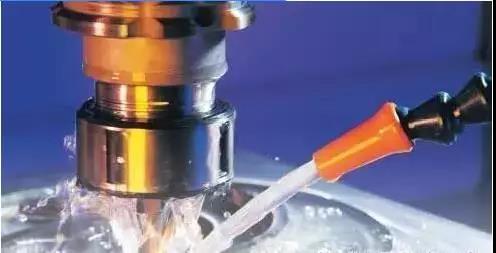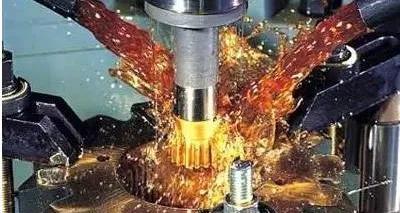Detailed explanation of the classification and application of cutting oil, a must-see for novices!
October 20, 2021
Detailed explanation of the classification and application of cutting oil, a must-see for novices! In metal processing operations, cutting oils can basically be divided into three categories: oil-based cutting oils, water-soluble cutting oils, and synthetic cutting fluids. 1. Oily cutting oil Oil-based cutting oils are generally made of low-viscosity mineral oil as the base, which is then mixed with other additives and does not need to be diluted when used. There are many different types of mineral oil, and their characteristics are also different. Some are suitable for cutting oil, while others are not. The oil in the Middle East is not the same as the oil in Venezuela, even if the oil produced by different oil wells in the same area is not the same. Through various refining processes, to a certain extent, the characteristics of oil products can be changed. But basically, some characteristics of the oil are difficult to change, that is to say, before adding additives, we have to make a correct choice among different base oils. Mineral oil is a mixture of a variety of hydrocarbons. Because of the difference in carbon link structure, there are several different component categories such as paraffin base, cycloalkyl and aromatic hydrocarbon base. Among them, the proportion of paraffinic Base Oil is higher, and the base oil with less aromatic hydrocarbon is better used to make cutting oil. The oil of this composition can be obtained by special solvent refining technology, and it also has the characteristics of high viscosity index. This oil has a relatively stable viscosity at high temperatures. High viscosity index oils are better because they have the following characteristics. It is not easy to be oxidized and has a long service life. It has little effect on temperature changes, and the film strength is better at high temperatures (such as the front end of the tool). It is relatively harmless to the skin (in the process of refining high viscosity index oils, some carcinogenic aromatic hydrocarbon structures can be removed). The rubber part of the machine is less susceptible to damage. The important characteristics of oil-based cutting oil are as follows: (1) Viscosity Viscosity is the ability of oil to maintain its own consistency, and it plays an important role in oily cutting oils. Low-viscosity oil is thinner and has better penetration and wetting power. If you choose appropriate additives, the oil can reach the cutting area more quickly. And because it is thin, its cooling and cleaning capabilities are better. High-viscosity oil is denser, has larger molecules, has better lubricity and greater metal surface isolation, but its fluidity and cooling properties are not as good as low-viscosity oils.
(2) Lubrication When metal is being cut, with different workpiece materials and different cutting speeds, different heat and pressure will be generated. The lubrication effect is mainly related to the lubrication of the tool surface in the sliding zone.

2. Water-soluble cutting oil (also known as emulsified oil) Generally, the water-soluble cutting oil is a concentrated liquid, and it is diluted with water according to the required proportion when using it. The diluted water-soluble cutting oil is called "emulsion". The water-soluble cutting oil is composed of mineral oil, emulsifier, anti-rust additive and other additives. Mineral oil is mixed with emulsifier and added to water to emulsify and form a suspension of oil in water. This solution is called "emulsion". The choice of mineral oil is the same as that of oil-based cutting oil, and it needs to contain less aromatic hydrocarbon groups. . The commonly used emulsifier is fatty acid soap mixed with sulfonated oil or non-ionic emulsifier. This composition has greater pollution tolerance and excellent emulsification stability. In the early days, soap was used as an emulsifier, but its stability to metal chips and salts was extremely poor. Many soaps are not compatible with mineral oil, so some co-dissolving solvents must be added to make the two can dissolve each other. This kind of additive with the characteristics of fusing two substances is called "coupling agent". Traditional coupling agents contain phenolic groups such as cresol and xylenol, but phenolic groups can produce peculiar smell; improper use can easily cause skin diseases, so the coupling agent without phenolic groups, such as synthetic alcohol, has been used. In addition to the water-soluble cutting oil, rust inhibitors, preservatives and defoamers are added. Under the microscope, it will be found that the emulsion is not a dissolving liquid, but the oil droplets are suspended or dispersed in water. There is a layer of negative charge on the surface of each oil molecule, which can prevent the oil droplets from merging. This effect maintains the stability of the water-based cutting oil.
The formation of negative charge, taking soapy water as an example, soap molecules are made of water-repellent hydrocarbons, which are bonded to a hydrophilic negative electrode, making the soap molecules look like tadpoles. The water-repellent positive electrode (tail part) goes deep into the oil droplet, and the hydrophilic negative electrode (head part) exists at the oil/water interface. Because the same-same charges repel each other, the oil droplets move in the solution, but will not touch, thus forming an emulsification. Liquid stable emulsions are distinguished by the size of suspended oil droplets. If there is less oil and more emulsifiers, the oil droplets will be smaller; if there are more oils and less emulsifiers, the oil droplets will be larger. The oil droplets of the milky emulsion are about 2--4u, and they appear white because they reflect better light. The oil droplets of the clarified emulsion are about 0.5-1.5u smaller, because the light is easier to pass through, so it is clear. The stability of the emulsion is maintained by the mutual repulsion of the negative charges on the outer layer of the oil droplets. Therefore, the intervention of any charge neutral agent will destroy its stability. The biggest enemies of emulsions are acids and salts. When these double-charged substances intervene, they will be decomposed into positive ions and negative ions. These numerous ions will disrupt the balance of the negatively charged layer of the oil droplets and cause the oil droplets to merge. Produce precipitation. The pH value is an index to measure the acidity and alkalinity of a liquid. Pure water is neutral and the pH is equal to 7; the pH of acid is less than 7, and the pH of alkali is greater than 7. Most soluble cutting oils are made by mixing soap sulfides and nonionic emulsifiers. They are generally weakly alkaline and have a pH between 8.5 and 10. When the PH value is high, it is easy to cause skin degreasing and damage; when the PH value is low, the emulsion loses its stability. Extreme pressure water-soluble cutting oil: Add sulfur and chlorine additives to water-soluble cutting oil. Its composition is similar to oil-based cutting oil. This oil is called extreme pressure water-soluble cutting oil. This oil combines cooling properties and extreme pressure lubricity, and can be used for heavy-duty processing; in some cases, it can replace oil-based cutting oil. Because of its wide cutting capabilities, extreme pressure water-soluble cutting oils are very commonly used in a variety of cutting processes.

3. Synthetic cutting fluid This type of cutting fluid has no oil at all. For example, the early soapy foamy water mixed with soda ash and other inorganic substances and water is generally called "chemical solution". Because there is no real lubricating ability, it is generally only used in grinding processing that only requires basic cooling performance. Recently, a new type of synthetic coolant containing water-soluble synthetic lubricant has been developed. This product is still a Fully Synthetic Cutting Fluid. Although it does not contain mineral oil, it has the advantages and disadvantages of water-soluble cutting oil and oil-based cutting oil. . If properly deployed, it has extremely high use value in some cases. Fully synthetic cutting fluid is a mixture of polymers and other organic and inorganic substances with water. It has been proven that they have excellent cooling and lubricity, especially when used in extremely high-speed cutting, the effect is better; synthetic cutting fluids are used in high-speed CNC machine tools and iron processing with surface cutting speeds exceeding 200 meters per minute Especially applicable. Because it is water-soluble rather than emulsified, synthetic cutting fluids are not as bad as water-soluble cutting oils. Because it does not contain mineral oil, it will not produce gas, smoke, and separation during use.

Principles of Using Water Concentration After adding water, the water-soluble cutting oil becomes an emulsified oil, which can take into account both cooling and lubricating properties. It is most suitable for general processing. The use concentration is 5-10%, and generally 5% is the most popular. Clarified water-soluble cutting oil, synthetic cutting fluid, used in grinding processing or processing that requires good cooling and wettability, but not very lubricating, the use concentration is about 1 to 2%. In high-speed cutting, the concentration of fully synthetic cutting fluid is about 2~3%. When used in higher load processing, the general use concentration is 10%, so that a sufficient amount of extreme pressure additives can be provided for use in the cutting area. Generally speaking, please follow the manufacturer's instruction manual when using it, because it is the result of careful consideration and testing. It is wise to use oily cutting oil of appropriate viscosity and water-soluble cutting oil and synthetic cutting fluid of appropriate concentration for processing.








